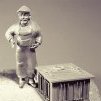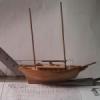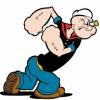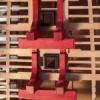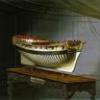Supplies of the Ship Modeler's Handbook are running out. Get your copy NOW before they are gone! Click on photo to order.
×
-
Posts
993 -
Joined
-
Last visited
Reputation Activity
-
 Wintergreen got a reaction from mtaylor in Altair 1931 by KeithAug - FINISHED - Scale 1:32 - schooner
Wintergreen got a reaction from mtaylor in Altair 1931 by KeithAug - FINISHED - Scale 1:32 - schooner
Is that Elena?
-
 Wintergreen reacted to EdT in Young America 1853 by EdT - FINISHED - extreme clipper
Wintergreen reacted to EdT in Young America 1853 by EdT - FINISHED - extreme clipper
Young America - extreme clipper 1853
Part 268 – Fore Upper Topsail Yard Parral 1: Wooden Yoke
All square yards above the lower topsails will be secured to their masts with parrals. These each consist of a wooden yoke bolted and strapped against the aft flat of the octagon at the center of each yard. The yoke is clamped to the yard by means of a hinged strap. The first picture shows the finished, but as yet unblackened, parral assembly fitted to the fore upper topsail yard.
The picture also shows the center sling band, the bands for quarter blocks and the holes drilled for the jackstay eyebolts. This part describes only the modeling of the wooden parral yoke. You will note in the picture that the inside of the mast opening is lined on the wood face. The lining of the hinged clasp will be done later. The next picture shows the wooden yoke before assembly.
The yoke has been notched for the sling band, but not yet for the two quarter bands.
The wooden yokes could be shaped manually, but more precision in the circular opening may be obtained by boring the opening using the milling machine fitted with a rotary table. Starting with an oversized wood blank, the circular opening of the yoke was bored first, followed by rip sawing to yield a half circle, then sawing the base, and finally shaping the curved sides. The circular opening was bored using the setup shown in the next picture.
The four jaw chuck conveniently centers and holds the piece. For modeling, the diameter of the opening will be 2" larger than the topmast diameter at the lower cap. This allows 1" for lining and 1" clearance. In practice, these allowances were more like a total of 1½" – ¾" for leather lining and a ¾" gap. The bore was made by centering a milling bit on the rotating table, offsetting the bit to cut the correct ID (= hole radius – bit radius), lowering the running bit through the piece and rotating the table a full 360 degrees. The resulting bore was very precise.
Centering the table on the mill spindle using the normal dial indicator method can be a tedious task – a lot of work for this single bore. The setup shown in the next picture simplifies and speeds up this task and yields sufficient accuracy for these borings.
The method uses two short lengths of close fitting telescoping tubing. The larger size is clamped in the four jaw chuck mounted on the rotary table. The smaller tube is chucked in the spindle. The X and Y tables are then adjusted until the tubes fit together smoothly as shown – centering the table. This is most easily done using the sensitive drilling attachment, which is then replaced by the milling chuck.
In the next picture, the yoke has been sawed to yield a half circle for the opening.
To accurately make this cut, the depth of wood below the bore was measured. To this was added one-half the bore diameter. Digital calipers were then set to this dimension and used to set the rip fence on the saw. After cutting the half circle, the rip fence was reset to the full depth of the yoke and the base excess sawed off. The curved faces of the yoke were then cut out on the scroll saw and finished with files/sanding. The notches for the bands were then filed out and the yoke glued to the yard as shown in the next picture.
You will note that the banding shown on the drawings in some of the photos was later corrected. Fitting this banding and making the hinge/clasp will be described in the next part.
Ed
-
 Wintergreen reacted to Jim Lad in Kågen by Wintergreen - FINISHED - 1:30 - Swedish clinker-built cog work boat - SMALL
Wintergreen reacted to Jim Lad in Kågen by Wintergreen - FINISHED - 1:30 - Swedish clinker-built cog work boat - SMALL
Still coming along nicely, Håkan. I wonder if you're cutting down the top sides of your planks just a little too much near the ends, thus having the accumulated error resulting in the effect that you see in your hull?
John
-
 Wintergreen reacted to SJSoane in Kågen by Wintergreen - FINISHED - 1:30 - Swedish clinker-built cog work boat - SMALL
Wintergreen reacted to SJSoane in Kågen by Wintergreen - FINISHED - 1:30 - Swedish clinker-built cog work boat - SMALL
Håkan,
That first photo shows just how complex the bevel must be to roll from clinker to carvel at the rabbet. Well done.
Mark
-
 Wintergreen got a reaction from CiscoH in Kågen by Wintergreen - FINISHED - 1:30 - Swedish clinker-built cog work boat - SMALL
Wintergreen got a reaction from CiscoH in Kågen by Wintergreen - FINISHED - 1:30 - Swedish clinker-built cog work boat - SMALL
Work continues,
first one of those rare grossly close-ups to show the rabbet at the stem.
And then, more planks convinced to stay in place. Hm... why does Gulliver and the land of Lilliput come to mind, I wonder...
-
 Wintergreen got a reaction from kees de mol in Kågen by Wintergreen - FINISHED - 1:30 - Swedish clinker-built cog work boat - SMALL
Wintergreen got a reaction from kees de mol in Kågen by Wintergreen - FINISHED - 1:30 - Swedish clinker-built cog work boat - SMALL
Work continues,
first one of those rare grossly close-ups to show the rabbet at the stem.
And then, more planks convinced to stay in place. Hm... why does Gulliver and the land of Lilliput come to mind, I wonder...
-
 Wintergreen got a reaction from cog in Kågen by Wintergreen - FINISHED - 1:30 - Swedish clinker-built cog work boat - SMALL
Wintergreen got a reaction from cog in Kågen by Wintergreen - FINISHED - 1:30 - Swedish clinker-built cog work boat - SMALL
Work continues,
first one of those rare grossly close-ups to show the rabbet at the stem.
And then, more planks convinced to stay in place. Hm... why does Gulliver and the land of Lilliput come to mind, I wonder...
-
 Wintergreen reacted to paulsutcliffe in Kågen by Wintergreen - FINISHED - 1:30 - Swedish clinker-built cog work boat - SMALL
Wintergreen reacted to paulsutcliffe in Kågen by Wintergreen - FINISHED - 1:30 - Swedish clinker-built cog work boat - SMALL
Nice job though on the planning hakan
Particularly like all the c**p behind in the picture ha!!!!!
Regards
Paul
-
 Wintergreen got a reaction from Mirabell61 in Kågen by Wintergreen - FINISHED - 1:30 - Swedish clinker-built cog work boat - SMALL
Wintergreen got a reaction from Mirabell61 in Kågen by Wintergreen - FINISHED - 1:30 - Swedish clinker-built cog work boat - SMALL
Work continues,
first one of those rare grossly close-ups to show the rabbet at the stem.
And then, more planks convinced to stay in place. Hm... why does Gulliver and the land of Lilliput come to mind, I wonder...
-
 Wintergreen got a reaction from popeye the sailor in Kågen by Wintergreen - FINISHED - 1:30 - Swedish clinker-built cog work boat - SMALL
Wintergreen got a reaction from popeye the sailor in Kågen by Wintergreen - FINISHED - 1:30 - Swedish clinker-built cog work boat - SMALL
Work continues,
first one of those rare grossly close-ups to show the rabbet at the stem.
And then, more planks convinced to stay in place. Hm... why does Gulliver and the land of Lilliput come to mind, I wonder...
-
 Wintergreen got a reaction from Mike Y in Kågen by Wintergreen - FINISHED - 1:30 - Swedish clinker-built cog work boat - SMALL
Wintergreen got a reaction from Mike Y in Kågen by Wintergreen - FINISHED - 1:30 - Swedish clinker-built cog work boat - SMALL
Work continues,
first one of those rare grossly close-ups to show the rabbet at the stem.
And then, more planks convinced to stay in place. Hm... why does Gulliver and the land of Lilliput come to mind, I wonder...
-
 Wintergreen got a reaction from cog in Kågen by Wintergreen - FINISHED - 1:30 - Swedish clinker-built cog work boat - SMALL
Wintergreen got a reaction from cog in Kågen by Wintergreen - FINISHED - 1:30 - Swedish clinker-built cog work boat - SMALL
Hi guys,
I'm glad for likes and questions.
Mark - yes, it is very much "by the eye". From the dead flat the builder can approximate the number of strakes needed, but the run... that's where I failed. That has to be done by eye. At stem and stern almost no plank has the same width. Try, and try again...
Druxey - I thought someone would eventually ask that question. No, they have an overlap all the way. From the book I learned that the last 6" get a bevel to half the thickness. And the coming plank is treated so as well, a bevel on the lower inside, closest to the stem/stern. That way the planks fit nicely and flush in the rabbet. (well, not SO nicely on my work, but nothing some sanding can't hide).
Now, it is back to the shop for some more planks...
-
 Wintergreen got a reaction from SJSoane in Kågen by Wintergreen - FINISHED - 1:30 - Swedish clinker-built cog work boat - SMALL
Wintergreen got a reaction from SJSoane in Kågen by Wintergreen - FINISHED - 1:30 - Swedish clinker-built cog work boat - SMALL
Work continues,
first one of those rare grossly close-ups to show the rabbet at the stem.
And then, more planks convinced to stay in place. Hm... why does Gulliver and the land of Lilliput come to mind, I wonder...
-
 Wintergreen got a reaction from CiscoH in Kågen by Wintergreen - FINISHED - 1:30 - Swedish clinker-built cog work boat - SMALL
Wintergreen got a reaction from CiscoH in Kågen by Wintergreen - FINISHED - 1:30 - Swedish clinker-built cog work boat - SMALL
Thanks for the likes and comments. Always appreciated.
Vaddoc, I think you remember correct. Up here it is well known that all clinker built boats needs a good soaking before they float. That is also true for many carvel built ones. I had a skerry qruiser once, carvel built. First season I cared for her she float when launched much to the disappointment for all old salts that "knew" she would sink like a rock.
Second season I did not have the time to care for her and she sank like a crayfish cage...
About hull shape.
No, definitely not by eye only. The builder used moulds or templates as can be seen here.
And I mimic that with my crude basic structure. However, to get the shape shapely is another matter.
Let me show you.
Bow view. Looks okay. No major problems.
Stern view. The planks meet the stern timber with an exaggerated arc.
Viewed from below the lines look okay. (Aft to the left).
But viewed from aside the aft section of the planking can be seen to do an uneasy bend.
(Aft to the right)
This is why I already from the start stated that this was the practice run. Otherwise I would have a hard time accepting it. Right now it is "good enough". Hopefully I can counteract this on my second try.
Side information. Above the backing plates are easily noticed. I put it on a scale and it weighed a whopping 8 grams/0.28 oz... sneeze and you will launch into straight off the bench...
-
 Wintergreen got a reaction from CiscoH in Kågen by Wintergreen - FINISHED - 1:30 - Swedish clinker-built cog work boat - SMALL
Wintergreen got a reaction from CiscoH in Kågen by Wintergreen - FINISHED - 1:30 - Swedish clinker-built cog work boat - SMALL
Thanks for checking in. Work progresses, albeit a bit slow.
Regarding the Viking long boats. I think the design worked in their favour. Both building rather big ships that sailed the North sea and Atlantic as well as their raids up on rivers in Russia and elsewhere.
Up river, when they came to a stream, they "just" hauled the boat out of the water and got some logs to roll it on until they'd got past the culprit. You don't do that with a 16th-17th square rigger...
Anyway, 5th strake is on. In the book, the 5th round is where he used three boards instead of two. I missed that and will cut the 6th strake in three pieces instead. Joggling the scarphs as I progress.
The shape is really hard to get right. The last couple of strakes are adjusted in-situ.
And a picture for reference..
To be continued...
-
 Wintergreen got a reaction from CiscoH in Kågen by Wintergreen - FINISHED - 1:30 - Swedish clinker-built cog work boat - SMALL
Wintergreen got a reaction from CiscoH in Kågen by Wintergreen - FINISHED - 1:30 - Swedish clinker-built cog work boat - SMALL
Okey, last post for the weekend.
Four strakes are on. As Vaddoc noted, they seemed to run high at the stem. Which I knew. This being learning by doing.
But, since wood is such a nice material to work with, things can be adjusted.
First picture. Before.
Second picture. After chisel and sandpaper.
I also have trouble amidships with the run of the planks dipping. No picture on that. Just a note to self.
Have a nice week!
-
 Wintergreen got a reaction from CiscoH in Kågen by Wintergreen - FINISHED - 1:30 - Swedish clinker-built cog work boat - SMALL
Wintergreen got a reaction from CiscoH in Kågen by Wintergreen - FINISHED - 1:30 - Swedish clinker-built cog work boat - SMALL
Thanks for the likes. Glad to see that there are readers.
Anyway, the day went. Grandkid came, and that was that. Now, she's asleep, so some time to type.
About spiling and clinker, or lapstrake, builds. This is my first attempt at this, so there will probably be lessons learned and working experience later on. However, compared to a carvel laid hull where planks fit long side to long side, and you quite easily can force later planks to the edge of the former, the clinker style means the planks overlap each other and thus form a stepped style. You probably know this already. Otherwise Wikipedia will help you understand.
From my short experience there are some major challenges with this.
You cannot force the plank in place sideways, it has to sit nicely. If force is used the overlap will be out of bounds. Hence, every plank needs more or less spiling. These boats are usually all about the shape. You have the sheer as with a carvel build. But with clinker we are reminded by every single strake if the run of the plank is off in some way. No steelers nor drop planks. Not an option. Every. single. strake. runs all the way from stem to stern. The challenge is to get the run of the planks right when the width of the plank changes. Eyeballing, proportional dividers, measure and measure again, then try. If not satisfied - repeat.
Unfortunately it is not as simple as just divide every frame/mould with decided number of strakes, then it will look very odd. As can be seen in my previous pictures the first strakes get wider at stem/stern. After two-three strakes the opposite will be true. All planks are narrower at stem/stern to fit in.
How to solve the issue with spiling. Basically it is the same as for carvel builds. Chuck, Druxey and others have written articles about it.
First I tried with cardboard of approximately same thickness as the planks. Didn't work too well. Hard to handle due to small size. Hard to see adjacent strake.
For the third strake I remembered that, I think, Chuck used transparent tape. It sticks to the moulds, easy to see and mark. Lacking transparent tape I used the regular painters masking tape and found that it was semi-transparent. Good enough.
One thing I picked up from Underhill's book was his practice of gluing thin material to a backing piece of cardboard or paper. My plank material is thin enough to easily be cut by #11, it will however splinter just as easily. With a broad piece of masking tape on one side - problem solved.
That had another advantage I found out later.
Enough text, show me some photos...
Here the cardboard templates are used.
Now, masking tape instead.
Stick tape to a white surface. Connect the dots with a smooth line.
Move tape to plank material and cut. Backing tape on other side.
The advantage with the backing tape is that it can be used as template for the accompanying plank port/starboard. By the way, leave the backing tape as long as possible.
Meaning all the rough shaping is already done. Every plank still need shaping to fit, but saved some time still.
Bending is performed with a dab of water and heatgun. Birch is very adaptable and bends easily. It holds edges fairly well also as can be seen in a previous post.
That was it for today.
To be continued...
-
 Wintergreen got a reaction from CiscoH in Kågen by Wintergreen - FINISHED - 1:30 - Swedish clinker-built cog work boat - SMALL
Wintergreen got a reaction from CiscoH in Kågen by Wintergreen - FINISHED - 1:30 - Swedish clinker-built cog work boat - SMALL
Hi guys,
the day is only half-gone here, but I just had to share this update with you.
First task for today was to clear a path to the shop... about 20cm/8" of snow overnight.
A short business trip took away a couple of days from the week, but back in the shop I made some progress.
Clinker/lapstrake is really something tricky to get right. Spiling and all that. In a later post I will show my trials and tribulations. On the trip I re-read H.A. Underhills chapter about clinker built boats, which was useful.
This far two full strakes are on. The scarphs are just plain butt ended with a backing piece on each. Joggled of course. Later each strake will be of three pieces.
Rubber bands and teak buns keep planks in place. I need to figure out some way to have the clamps not slipping off. Maybe a bit of tape will do the trick with enough friction.
Backing pieces have beveled edges for appearance. Should be pinned also, will see if I do that.
I am really enjoying this build. The result is far from perfect, but this is also my first time doing this. And since I have this first build as a practice run, my second will undoubtedly be better.
To be continued...
-
 Wintergreen got a reaction from G.L. in Kågen by Wintergreen - FINISHED - 1:30 - Swedish clinker-built cog work boat - SMALL
Wintergreen got a reaction from G.L. in Kågen by Wintergreen - FINISHED - 1:30 - Swedish clinker-built cog work boat - SMALL
Work continues,
first one of those rare grossly close-ups to show the rabbet at the stem.
And then, more planks convinced to stay in place. Hm... why does Gulliver and the land of Lilliput come to mind, I wonder...
-
 Wintergreen got a reaction from kees de mol in Kågen by Wintergreen - FINISHED - 1:30 - Swedish clinker-built cog work boat - SMALL
Wintergreen got a reaction from kees de mol in Kågen by Wintergreen - FINISHED - 1:30 - Swedish clinker-built cog work boat - SMALL
Thanks for the likes and comments. Always appreciated.
Vaddoc, I think you remember correct. Up here it is well known that all clinker built boats needs a good soaking before they float. That is also true for many carvel built ones. I had a skerry qruiser once, carvel built. First season I cared for her she float when launched much to the disappointment for all old salts that "knew" she would sink like a rock.
Second season I did not have the time to care for her and she sank like a crayfish cage...
About hull shape.
No, definitely not by eye only. The builder used moulds or templates as can be seen here.
And I mimic that with my crude basic structure. However, to get the shape shapely is another matter.
Let me show you.
Bow view. Looks okay. No major problems.
Stern view. The planks meet the stern timber with an exaggerated arc.
Viewed from below the lines look okay. (Aft to the left).
But viewed from aside the aft section of the planking can be seen to do an uneasy bend.
(Aft to the right)
This is why I already from the start stated that this was the practice run. Otherwise I would have a hard time accepting it. Right now it is "good enough". Hopefully I can counteract this on my second try.
Side information. Above the backing plates are easily noticed. I put it on a scale and it weighed a whopping 8 grams/0.28 oz... sneeze and you will launch into straight off the bench...
-
 Wintergreen got a reaction from kees de mol in Kågen by Wintergreen - FINISHED - 1:30 - Swedish clinker-built cog work boat - SMALL
Wintergreen got a reaction from kees de mol in Kågen by Wintergreen - FINISHED - 1:30 - Swedish clinker-built cog work boat - SMALL
Thanks for checking in. Work progresses, albeit a bit slow.
Regarding the Viking long boats. I think the design worked in their favour. Both building rather big ships that sailed the North sea and Atlantic as well as their raids up on rivers in Russia and elsewhere.
Up river, when they came to a stream, they "just" hauled the boat out of the water and got some logs to roll it on until they'd got past the culprit. You don't do that with a 16th-17th square rigger...
Anyway, 5th strake is on. In the book, the 5th round is where he used three boards instead of two. I missed that and will cut the 6th strake in three pieces instead. Joggling the scarphs as I progress.
The shape is really hard to get right. The last couple of strakes are adjusted in-situ.
And a picture for reference..
To be continued...
-
 Wintergreen got a reaction from oneslim in Kågen by Wintergreen - FINISHED - 1:30 - Swedish clinker-built cog work boat - SMALL
Wintergreen got a reaction from oneslim in Kågen by Wintergreen - FINISHED - 1:30 - Swedish clinker-built cog work boat - SMALL
Work continues,
first one of those rare grossly close-ups to show the rabbet at the stem.
And then, more planks convinced to stay in place. Hm... why does Gulliver and the land of Lilliput come to mind, I wonder...
-
 Wintergreen reacted to egen in HMS Euryalus by egen -
Wintergreen reacted to egen in HMS Euryalus by egen -
Hello Friends.
I bring myself regrets that my work so strongly dragged on, but I didn't put the end to the work yet.
I still hope that I will be able to finish.
And recently I received the order for guns and I was so delighted that I am simply obliged to tell about this master and to show his work.
A little advertizing is only a small part that I can make that once again.
This is Dmitry Shevelev . We can see his works at the Russian forum as the ship modeller, or even met him in the championships on NAVIGA in Europe.
I will a little tell that it does cast models of white metal, completely covers them with copper and covers in black color.
I can't precisely express as it will be in English, but work is performed in due form. These are 100% a ready product, about $2,5 per gun.
You can specify all details, having written to it on mail on English language. His email is modelist69@yandex.ru
There is a possibility of delivery to other countries by means of EMS Russian the Post.
Thnks for photos by Piter
-
 Wintergreen reacted to SJSoane in HMS Bellona 1760 by SJSoane - Scale 1:64 - English 74-gun - as designed
Wintergreen reacted to SJSoane in HMS Bellona 1760 by SJSoane - Scale 1:64 - English 74-gun - as designed
Thanks, druxey.
When I started working this morning, I noticed that where I left off last night shows just how much the hooked scarphs interlock. I was initially skeptical that those relatively small hooks would make a difference, but modeling the joint has shown me the exceptional strength this joint has created.
Mark
-
 Wintergreen reacted to EdT in Young America 1853 by EdT - FINISHED - extreme clipper
Wintergreen reacted to EdT in Young America 1853 by EdT - FINISHED - extreme clipper
Young America - extreme clipper 1853
Part 267 – Halyard Gin blocks
In preparation for work on the upper topsail yard, I decided to make the iron gin blocks for the halyards for all three of these yards. These are suspended aft of each topmast from a chain tye shackled to the central band on the yard. The tye passes through the sheave just below the topmast hounds. There is one of these iron tye blocks for each of the three upper topsail yards. They allowed the load of these relatively heavy yards to be distributed to both sides of the ship by means of tackles that will be described later. The heavy stationary yards below are supported by iron trusses as previously described, while those above have simpler, lighter halyard rigging. The first picture shows the three finished gin blocks.
The blocks have inverted T frames that house iron sheaves and an eye at the top to attach the chain tye. Two have 12" diameter sheaves, one 10". The frames could be made from formed metal strips, but I chose to use flattened brass tube for these. The tube was flattened in a vise as shown in the next picture.
Pieces were then sawed off and given some shaping to form parts for the basic two-piece assembly shown in the picture. It was then a simple matter to silver-solder these using the setup shown below.
One side at a time was soldered. The frames were then further refined in size and shape as shown in the next two pictures.
The brass strip holding the frame in the above picture served as an anvil to impart some squareness to the frames and to straighten the sides. The strip also allowed the frames to be center-punched for drilling without deforming the shape. In the next picture the eyebolt has been soldered into a small hole in the top of the frame and the sheave pin holes are about to be marked for drilling.
A wooden spacer was inserted into each frame to avoid bending during rilling of the axle holes. The last picture shows the completed blocks before blackeneing.
The sheaves were turned and drilled in the lathe from brass rod, then secured with peened copper pins. The assemblies were then polished, cleaned, and blackened using Brass Black®. Meanwhile, work progressed on the upper yard itself – next post.
Ed




